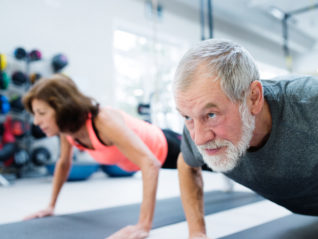
by Bianca Garilli, ND
Regular physical activity is a cornerstone of public health policy in most age groups, with the typical adult recommendation at > 150 minutes/week of aerobic exercise along with routine strength training or weight bearing exercise sessions. The benefits of consistent physical activity is well documented, including reducing risk of chronic illness and improving body mass index, weight and mood among other conditions. The role that regular physical activity plays in older adults, however, continues to expand with new research indicating an even greater benefit than previously realized in this rapidly growing age demographic which, in the US is projected to comprise 23.5% of the population by 2060.1
The Lifestyle Interventions and Independence for Elders (LIFE) study was a multicenter, single-masked, randomized controlled trial enrolling 1635 sedentary men and women aged 70-89 years old with functional limitations.2 The participants were followed for an average of 2.6 years to determine if a structured, moderate intensity walking, resistance, and flexibility physical activity program provided better outcomes than a health education program. The physical activity arm of the study included walking-based aerobic, resistance, flexibility, and balance training in a supervised class setting (2x per week), with additional home-based physical activity goals. The aim was to progressively move participants towards at least 150 min/week of moderate intensity physical activity.2
Participants were assessed at baseline, 6, 12 and 24 months for performance on 400 meter walk gait speed, and the Short Physical Performance Battery (SPPB). At the end of the study, it was found that individuals in the physical activity group experienced dose-dependent improvements in physical functioning and attenuation in the onset of major mobility disability. These positive and clinically meaningful outcomes were observed with small increases of regular physical activity (>48 min/week).2
The results and conclusions of this trial are consistent with previous research findings demonstrating that regular physical activity in the older adult population improves long-term health outcomes and should therefore, be part of a regular health and wellness routine recommended by healthcare providers and included in public health efforts. Regular physical activity in older adults has been shown to:
- Prevent long-term mortality, with higher intensity physical activity levels associated with lower risks of mortality3
- Reduce risk for dementia4
- Reduce systemic inflammation as measured by IL-6 levels5
- Lower the risk of falls and subsequent hospitalizations through reduction of physical frailty and sarcopenia6
- Increase long-term mobility and independence7
Why is this Clinically Relevant?
- Regular physical activity reduces mortality and risk of chronic disease and improves well-being and independence in older adults
- Healthcare providers should discuss, recommend and partner with their older patients to help them progressively increase their physical activity to meet public health guidelines
- A regular routine of aerobic, flexibility, strength training and balance should be the goal for older adults
Citations
- Office of Disease Prevention and Health Promotion. Older Adults. https://www.healthypeople.gov/2020/topics-objectives/topic/older-adults Accessed April 19, 2018.
- Fielding R, Guralnik J, King A, et al. Dose of physical activity, physical functioning and disability risk in mobility-limited older adults: Results from the LIFE study randomized trial. PLoS One. 2017;12(8).e0182155.
- Llamas Velasco S, Villarejo-Galende A, Contador I, Lora-Pablos D, Hernández-Gallego J, Bermejo-Parejab F. Physical activity and long-term mortality risk in older adults: A prospective population based study (NEDICES). Prev Med Rep. 2016;4:546–550.
- Llamas-Velasco S, Contador I, Villarejo-Galende A, Lora-Pablos D, Bermejo-Pareja F. Physical activity as protective factor against dementia: a prospective population-based study (NEDICES). J Int Neuropsychol Soc. 2015;21(10):861-867.
- Thielen JW, Kärgel C, Müller BW, et al. Aerobic activity in the healthy elderly is associated with larger plasticity in memory related brain structures and lower systemic inflammation. Front Aging Neurosci. 2016;8:319.
- Lozano-Montoya I, Correa-Pérez A, Abraha I, et al. Nonpharmacological interventions to treat physical frailty and sarcopenia in older patients: a systematic overview – the SENATOR Project ONTOP Series. Clin Interv Aging. 2017;12:721–740.
- Taylor D. Physical activity is medicine for older adults. Postgraduate Med J. 2014;90(1059):26-32.




